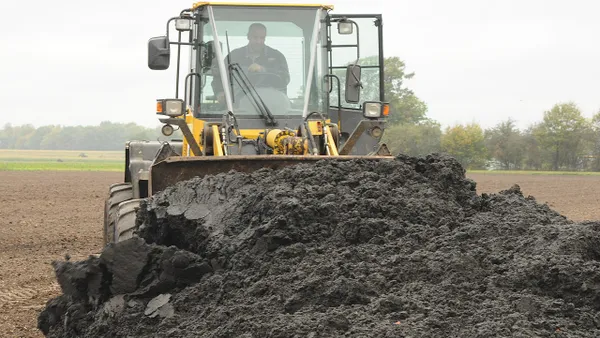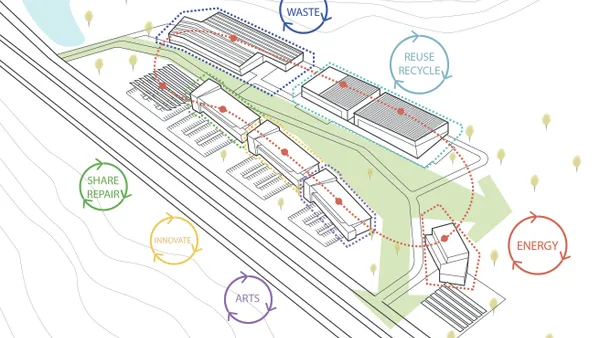The green packaging market has seen rapid growth in recent years due to advances in technology, heightened interest in circular economy principles, and a cultural interest in more sustainable products. While questions still remain about the lifecycle of these innovations, many are easier to recycle and more biodegradable than their predecessors.
A number of interesting ideas have already made headlines this year and while some are still in the prototype phase, they all have exciting potential for reducing and changing the waste stream. Waste Dive took a look at some of the standouts.
Toothpaste pods
According to Poppits, more than 1 billion toothpaste tubes are sent to landfills every year and they can take hundreds of years to break down. That's why Poppits developed a solution: a toothpaste-filled cellulose pod that can break down inside a person's mouth within five seconds. Inventor Wayne Solan told Co.Exist the product is vegetarian and halal friendly and has even attracted interest from NASA for use on the International Space Station. While a recent Kickstarter campaign missed its mark, the idea of eliminating curled up toothpaste tubes from the trash has a lot of promise.
Edible six-pack rings
Six-pack rings are a common sight in photos of marine life affected by ocean plastic, but one Florida-based beer company has found a way to curb such waste. Working with ad agency We Believers and biodegradables manufacturer Entelequia Inc., Saltwater Brewery will soon begin producing rings made from spent grain rather than plastic. These rings can break down within two to three months, won't harm wildlife, and will give brewers a new use for a material they often paid to dispose of or gave to farmers. Production is planned to start at 400,000 units per month with the hope of influencing larger national companies soon after.
Eggshell plastic
Eggshells can be useful for home composting, but on an industrial scale they’re a challenge. U.K. company Just Egg, which peels 1.5 million eggs per week for use in mayonnaise and other products, teamed up with scientists from Leicester University in 2012 to find a way to divert the shells from the waste stream. Since the shells are made of calcium carbonate — a chalk-like substance — they can be ground into a powder and used as reinforcement filler in plastics. The researchers are also looking into medical uses for the egg membrane. A team from Alabama’s Tuskegee University has been exploring a similar method which uses ultrasound to break the shells into small particles that could be used in food packaging.
Mushroom packaging
Dell has been using mushrooms as part of its move toward more sustainable packaging and Ikea garnered many headlines this spring when it began exploring the material. The product is made by a New York firm called Ecovative using mycelium-fungi — basically mushroom roots — and agricultural waste such as corn husks. Though Ikea hasn’t begun using the material yet, it could make a noticeable dent in the amount of polystyrene foam which is currently used to pack the company’s large boxes of furniture and isn’t accepted for recycling in most municipalities.
Edible cutlery
Indian company Bakeys has taken biodegradable packaging and products a step further by encouraging users to eat it once they’re done. The company’s cutlery is made primarily from millet flour — which requires less water than rice — along with wheat and rice flours. Bakeys' spoons, forks and chopsticks come in sweet, savory, or plain flavors. If they’re not eaten they will biodegrade within four to five days. The company estimates that 120 billion pieces of disposable cutlery are thrown away in India alone every year with most going to landfills.
Shrimp shells
A team of researchers from the National University of Singapore have created a material similar to polyethylene film using grapefruit seed extract and chitosan from shrimp shells. The material’s antibacterial and fungicidal properties make it ideal for food packaging. Researchers estimate that it could double the shelf life of items such as bread, which could have big implications for food waste. They also think the film could be used in seafood, meat, and cheese packaging.
Seaweed
Last year, London-based Skipping Rocks Lab debuted a new spherical packaging made from seaweed and and calcium-chlorine membrane called Ooho!. The salty plant has been in the news again this spring because of a jelly-like substance called agar which can be derived from types of marine algae such as red seaweed. A design student from the Iceland Academy created an agar bottle that decomposes once empty and a team of Japanese designers known as AMAM won this year’s Lexus Design Award for their work with the material. They found the potential for creating alternatives to foam packaging or plastic film that could even improve soil quality by increasing water retention properties.












